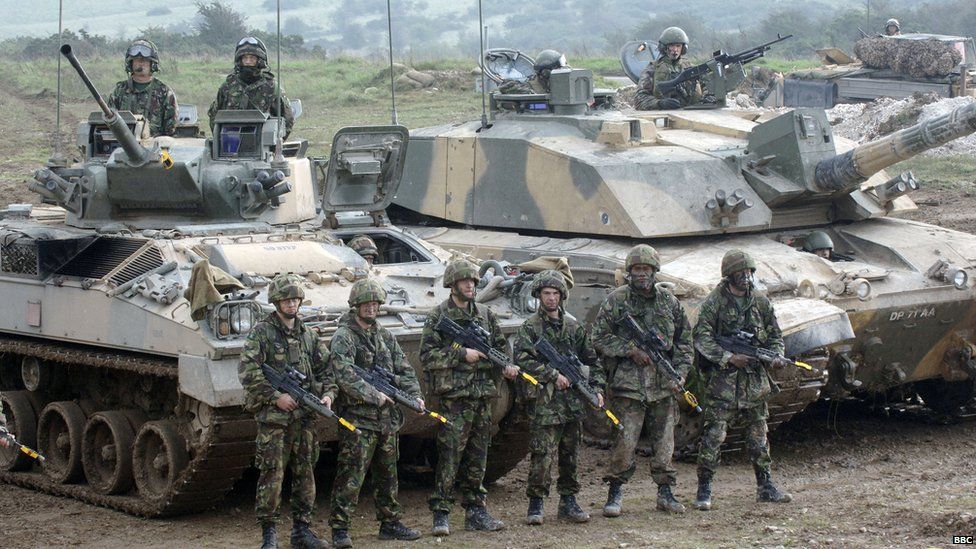British Army could axe ageing tanks as part of modernisation plans
- Published

Is the nation which invented the tank about to abandon it?
The British Army's Challenger 2 tank is already old.
In 2019 the then defence secretary, Penny Mordaunt, went as far as to suggest it was obsolete. She noted: "Challenger 2 has been in service without a major upgrade since 1998.
"During this time the US, Germany and Denmark have completed two major upgrades, whilst Russia has fielded five new variants, with a sixth pending."
Previous defence reviews have also seen tank numbers slashed from more than 500. Theoretically, the Army still has 227 Challenger 2 tanks. But in reality only about half of those are out of storage and ready to be deployed.
The Army has been looking at a number of options to modernise its fleet of tanks for almost a decade. They include buying German Leopard 2 tanks, or modernising the Challenger 2 with a new turret and gun.
But senior Army officers have also confirmed to the BBC that they've recently been considering whether they could do without them altogether. While mothballing them could also be an option, there seems to be little point in storing old tanks - unless they're for a museum.
A shift in thinking has been highlighted by the head of the Army, General Sir Mark Carlton Smith. In a recent speech he suggested the threat of the tank was diminishing in modern warfare.
He said: "The main threat is less missiles and tanks. It's the weaponisation of those elements of globalisation that hitherto have made us prosperous and secure, such as mobility of goods, people, data and ideas."
Defence chiefs have talked of investing in new "sunrise capabilities" such as cyber and electronic warfare, and reducing "sunset capabilities", without spelling out what that might include.
Defence Secretary Ben Wallace has also underlined change ahead. He has promised to invest more in the domains of space and cyber and new unmanned systems on land, sea and air.
Without a significant rise in defence spending, that will require scrapping obsolete equipment to invest in the new.
A combination of underinvestment, poor management and long counter-insurgency campaigns in Iraq and Afghanistan has left the Army with a glut of ageing equipment. It currently has 15 different types of armoured vehicle in service with some close to the end of their life.
A programme to modernise the Army's 700 Warrior armoured vehicles has suffered serious cost overruns and delays.
The UK has also failed to keep up with advances in artillery, missile defence and firepower. Dr Jack Watling, of the Royal United Services Institute, a defence think tank, says it now faces a stark choice between modernising its armour, or prioritising firepower and mobility. He says "it can't afford to do both".
Britain would not be the first country to abandon the tank. The Dutch army has all but given up its heavy armour, though it retains a small number of tanks and has soldiers embedded within German armoured units.
The US Marine Corps is also turning away from the tank as it focuses on mobility. Moving tanks around the world, even Europe, requires considerable transport and logistical support. But in the case of America, the US army will still be investing in heavy armour.
Soldiers staged an attempt to set a new world record to pull a Challenger 2 battle tank
The reality is that despite perceived changes in warfare, the main military powers are still investing heavily in heavy armour.
Michael Clarke, professor of defence studies at King's College London, notes: "The emphasis on the heavy metal of military forces is seen as a shibboleth of old thinking in an era that is fast disappearing for everyone - except the super power."
If the Army did abandon the tank, then it would have to reassure its allies it would be investing elsewhere in defence.
One particularly important ally might have major concerns. When aircraft carriers were abandoned in 2010, the then US secretary of defence Robert Gates concluded the UK was no longer a "tier one" military power because it did not have a "full spectrum of capabilities".
Defence reviews inevitably lead to speculation about cuts to the armed forces and its equipment. The government has promised this time will be different.
Downing Street has described the newly named Integrated Defence and Security Review as the most comprehensive policy review since the end of the Cold War. But as with previous reviews, defence ministers and chiefs are still facing significant financial pressures and having to work out what they can afford.
It's not just tanks being looked at, but the types and numbers of warships and aircraft and the overall size of the armed forces. Such speculation will intensify as the review draws to a conclusion later this autumn.
In the end, the decision whether to scrap tanks will be a political decision, not a military one.
- Published26 June 2020
- Published16 August 2019
- Published3 February 2016
- Published24 February 2014
- Published2 April 2003